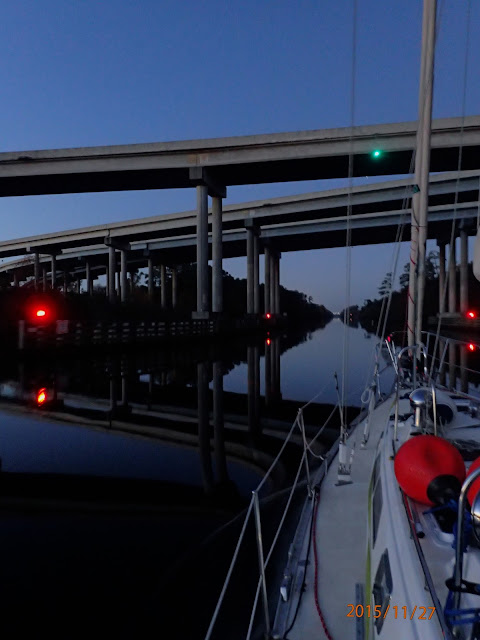posted by Ardys
We stayed an extra day at Barefoot Landing Marina for two reasons: One — it was Thanksgiving and I required pumpkin pie; and two — we needed time to plan for the next day. A healthy amount of anxiety was already in play about the next leg of our journey. Perhaps a big Thanksgiving dinner would help with the planning? Or not.
 |
| Barefoot Landing carnival etc. |
 |
| Bridges 1 and 2 for today at nautical twilight |
The two Socastee Bridges, a swing bridge and a fixed bridge were the primary cause for our concern and the reason for our early departure. They would be Bridges 8 and 9 for the day. The swing bridge was not going to be a problem in and of itself, because the operator would open it on request, but the fixed bridge came immediately following the swing bridge. If we couldn’t fit under the fixed bridge, we would effectively be trapped between the two bridges for a while. Carl lost some sleep worrying about this possibility.
Bridges 1, 2, 3 and 4 weren’t of particular concern to us, but I listened for the sound of pings when we went under them anyhow, and there were none. A “ping” would indicate that our antennae was bumping against the iron support beams above us. Anything louder than that would indicate something much worse, aka more expensive. We knew Bridges 5 and 6 were going to be close, but we weren’t worried about them. We were a little surprised therefore when I herd 4 distinct pings going under the fifth and one ping under the 6th bridge. The seventh was clear sailing. After touching two bridges already, we were especially concerned about the Socastee Bridges.
 |
| My boys, pondering different things no doubt |
We reviewed the special preparations we had made the night before—just in case we would need to “reduce” the height of the mast to get under the Socastee fixed bridge. Of course one cannot actually reduce the mast height, but if the mast could be made to lean to one side, that would, in essence reduce the height. Carl developed a plan and we set up some of the required rigging in advance to the extent possible.
The Plan: If necessary, we would push the boom way out to the side so that it hung over the water and secure it in place with a preventer.* The dinghy and its’ heavy outboard would be brought alongside the boat under the boom. The halyard would then be run through the furthest attachment point on the end of the boom and then be connected to a line suspended between the attachments for the dinghy davits. We would then winch the halyard up tight, thereby using the weight of the dinghy and motor to help pull the mast to one side a little. We put ourselves through the paces of how this system would work before going to bed.
 |
| The Socastee swing bridge and then the dreaded fixed bridge |
When we approached the Socastee Bridges, we reviewed the plan again. We would have to request the bridge operator to reopen the swing bridge as soon as possible if we were stuck between them, but there was no assurance that would be possible. With NORTHERN STAR’S engine just idling, we crept toward what we had now decided was an evil fixed bridge. The bridge operator was kind enough to point out that the bridge was slightly higher on the left and sloped toward the right so we aimed for the far left side. We slid under without touching at all! And no extraordinary mast shortening tactics needed.
We were so elated about making it under the Socastee Bridge that we were a few miles past our intended anchorage for the evening before we noticed it. So, we went on to a lovely anchorage called Cow House Creek and were glad we did. It’s a beautiful, quiet anchorage in a wilderness area. We kept an eye out for alligators and brought Jax to a dinghy dock on the other side of a small island off the ICW where Jax met a turtle. They apparently didn’t have much in common because the turtle kept on moving, very... very... slowly.
 |
| Beautiful swamps. No alligator sightings, yet |
We were so elated about making it under the Socastee Bridge that we were a few miles past our intended anchorage for the evening before we noticed it. So, we went on to a lovely anchorage called Cow House Creek and were glad we did. It’s a beautiful, quiet anchorage in a wilderness area. We kept an eye out for alligators and brought Jax to a dinghy dock on the other side of a small island off the ICW where Jax met a turtle. They apparently didn’t have much in common because the turtle kept on moving, very... very... slowly.
*A preventer is a line attached to the boom and tied off to one side. Typically it's used to prevent an accidental jibe when sailing downwind.





2 comments:
Glad to hear you made it through the Socastee bridge alright!
Me, too. Whew!
Post a Comment